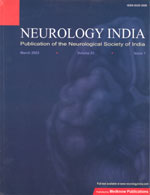
|
Neurology India
Medknow Publications on behalf of the Neurological Society of India
ISSN: 0028-3886
EISSN: 0028-3886
Vol. 57, No. 4, 2009, pp. 411-417
|
 Bioline Code: ni09119
Bioline Code: ni09119
Full paper language: English
Document type: Research Article
Document available free of charge
|
|
|
Neurology India, Vol. 57, No. 4, 2009, pp. 411-417
| en |
Interhemispheric interaction in the motor domain in children with cerebral palsy
Zaytseva, Nadezhda V.; Walid, M. Sami & Berdichevskaia, Elena M.
Abstract
Background : The attention of pediatric specialists has been continuously attracted to the problem of
cerebral palsy (CP) and the formation of behavioral and motor skills in the initial years of life in these patients. This work aimed
at studying the specifics of intra- and interhemispheric connections in the motor domain in children with CP as well as their dynamics
in the process of rehabilitation using hand/finger synkineses and and lateral profile as markers.
Materials and Methods :
A total of 215 children aged 4-7 years were recruited after obtaining their parents′ consent, including 95 patients with the
most prevalent forms of CP (spastic diplegia, hemiparetic form) who underwent complex treatment in a neuropsychological sanatorium
and 120 healthy children from a kindergarten. Data were analyzed using nonparametric methods and the chi-square test with the help
of the statistical program SPSS v.14.
Results : Changes in the scores and types of synkinesis after rehabilitation indicated
that in spastic diplegia the assumed symmetric brain defects were associated with uniform restoration of interhemispheric connections
and less disturbance of intrahemispheric connections. In hemiplegia, on the contrary, misbalance in intrahemispheric connections
prevailed and compensation was noticed only in left-hemispheric pathology. The magnitude, type, and improvement of hand synkineses
in the course of treatment depended on the lateral phenotype.
Conclusion : Hand/finger synkineses in CP children
change with rehabilitation. The methods used in the study can be recommended for application in the system of medico-biological
and psycho-pedagogical monitoring of children with CP.
Keywords
Cerebral palsy, synkinesis, functional asymmetry
|
| |
© Copyright 2009 Neurology India.
Alternative site location: http://www.neurologyindia.com
|
|
